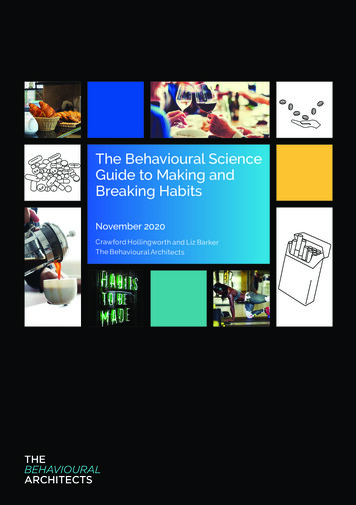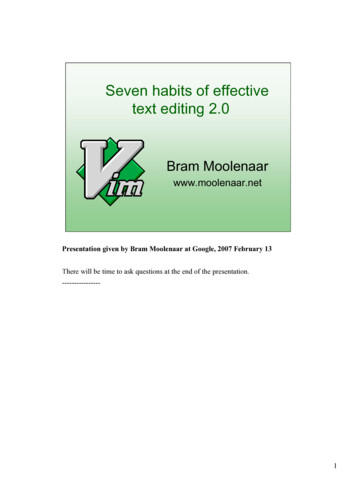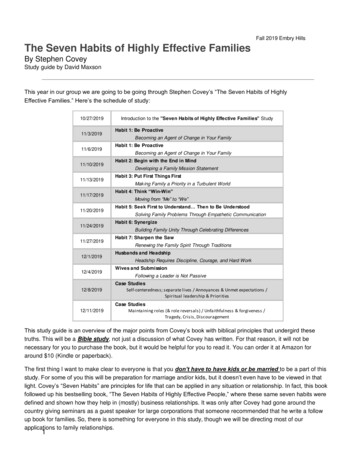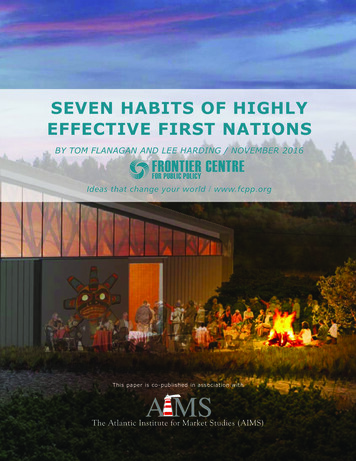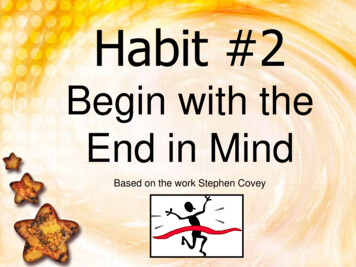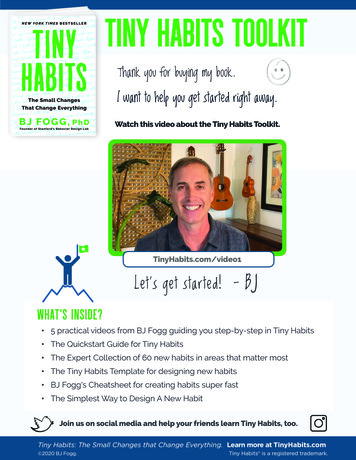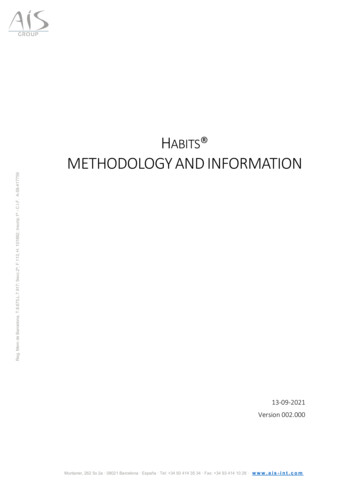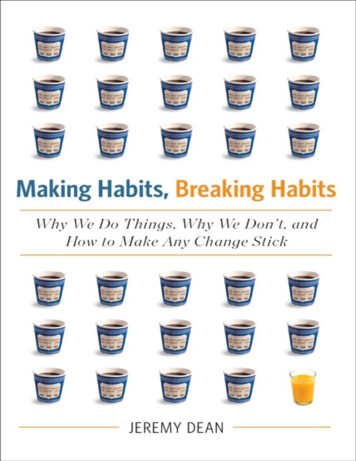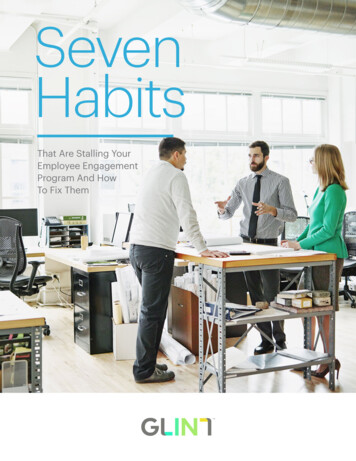
Transcription
SevenHabitsThat Are Stalling YourEmployee EngagementProgram And HowTo Fix Them
Let’s face it: Top talentis difficult to find.Skilled employees don’t just want a steady job. An excellentculture, a sense of purpose, company prospects, and many otherfactors have overtaken compensation and job security as themost important factors in the decision to join an organization,stick around, and, more importantly, perform at one’s best.It’s not just a generational thing; it’s aworkforce thing. Technology has given us all anunprecedented ability to find, assess, and connectwith new opportunities. Switching companiesdoesn’t require the leap of faith it once did. AndLinkedIn provides insider access to everyone,illuminating everything from the interviewprocess to company culture and what salaryrange to expect.The world has changed. And yet, traditionalmethods of engaging and retaining our peoplecontinue to reign supreme. Organizations areusing engagement methods that just are notfast enough to keep pace with demand fromemployees and leaders—even in the faceof higher attrition, shorter tenures, andincreased recruiting costs.Along with these traditional methods comeseveral bad habits that are costing today’sorganizations millions of dollars each year in lostperformance and talent. While these habits mayhave represented the cutting edge five to tenyears ago, they now represent a lost opportunityto truly understand, collaborate with, and improvethe engagement and commitment levels of today’semployees. As the world continues to becomemore agile, more connected, and more real-time,these mistakes will become glaring.It’s time to bring employee engagement intothe future. High-performing organizations areadopting modern technologies that will driveenergy, focus, and performance at work.This whitepaper will help you evaluate andupdate your employee engagement andretention strategies. Read on to. explore the latest challenges and demandson engagement and retention programs, learn about seven bad habits of today’sorganizations that undermine strategy, pick up seven future-ready habits that highperforming organizations use to be moreeffective, more predictive, and moreimpactful on business results.Discover why it’s time to make a change—and howyou can change your habits to become a highperforming organization of the future.
Emerging TrendsImpacting EmployeeEngagementFour trends in the workplace have made employeeengagement a front-burner issue that organizationscan no longer ignore.The hiring dynamic has flipped.Due to a global scarcity of top talent, skilledemployees now have the ability to pickand choose where they want to work—andwhat they want to get out of it. That meansmore responsibility lies with employers toaccommodate the demands of top talent (withinreason). If employees aren’t getting what theyfeel they need, whether that’s recognition, growthopportunities, a sense of purpose or any numberof things, they are likely to leave.Giving “Rock Star Talent”A New MeaningThe shortage of top talent likeengineers, for example, is sosevere that employee-focusedtalent agencies are popping upwith the sole purpose of seekingout new opportunities forengineers and fighting for highlydesirable employment situationsfor top talent.1 Seven Habits That Are Stalling Your Employee Engagement ProgramThe majority of employees are candidatesfor another jobIt’s no secret that a loyalty-centric employmentvalue proposition is essentially a thing of thepast. In addition to the overwhelming evidencethat we’re in a “seller’s market” when it comesto recruiting talent, today’s workforce is alsodisillusioned, with strong memories of the falloutof the economic meltdown of 2008-2009.Employees learned the hard way that employerloyalty will only extend so far—and realized thatwhen it comes to career development and jobsecurity, it’s every-person-for-herself.This mentality, combined with unprecedentedaccess to one’s professional and personalnetworks, means “job hopping” isn’t a taboo,at least not for the Millennial generation. In fact,it’s almost expected of high performers—57%of Millennials believe that changing jobs oftenis good for their careers.The data agrees: More employees are switchingjobs more frequently, and those who aren’tleaving are increasingly open to it. The “quit rate”increased 17% in 2015. Active jobseekers (thoseenthusiastically looking for new opportunities) are
now 30% of the workforce. And “warm, passive”candidates—those who are open to speaking witha recruiter or are already reaching out to theirnetworks—now make up 57% of the workforce.Today, that public image lies squarely in thehands of current and former employees, who aremore than willing to leave brutally honest reviewsof everyday life at an organization on socialmedia. Just as Yelp and Rotten Tomatoes are thenew sources of truth when choosing a restaurantor movie, potential employees will diligentlyconsult Glassdoor or Indeed.com about theorganization before choosing to apply, interview,or accept an offer.It is equally concerning that the overwhelmingmajority of organizations admit to being unclearwhen it comes to what motivates their people.It’s no coincidence that most employees have atleast one foot out the door. Getting a grip on howto engage and retain employees is now a majordifferentiator for high-performing organizations.With half of jobseekers consulting thesecrowdsourced reviews to help in theiremployment decisions, negative assessmentshave a big impact on potential talent whoare evaluating the organization’s cultureonline. The good news is, by improvingemployee engagement and opening the linesof communication between leadership andemployees, organizations can help convertEmployer brands are a reflection of theemployee voice—for better or worseHistorically, the employer brand was controlledin tandem by the HR and Marketing departments.It was their job to post happy-looking picturesof their employees to the company website andhighlight their volunteer programs to create andmaintain a positive reputation.Is your companyon trend? Then87 percent ofyour employeescould be open toa new job. Maybeit’s time to goagainst the grain.13%87%of your employees couldbe open to a new job2 Seven Habits That Are Stalling Your Employee Engagement Program*LinkedIn, Why & How People Switch Jobs, 2015
We communicate ina way that’s alwayson and increasinglyreal-time.negative sentiment before it becomes a PSA as towhy they shouldn’t interview with your company.People are connected in ways we previouslythought unimaginableMost workplaces today would be unrecognizableto Don Draper or Gordon Gekko. How wecommunicate and collaborate with ourcoworkers, peers, and leaders has undergonesignificant change since Wall Street. We workin “borderless” environments, defined not bywalls or even geography, but rather commonprojects and goals. Connecting with a colleagueon a different continent is only slightly morechallenging than one in the next cubicle.We communicate in a way that’s always onand increasingly real-time: social networkshave forever altered our expectations for the3 Seven Habits That Are Stalling Your Employee Engagement Programimmediacy and reach of our interactions.Real-time feedback is pervasive. Our personaldecisions are increasingly crowdsourced, withopinions from strangers on Yelp or Amazonholding far more weight than advertisements andsalespeople.Additionally, technology has helped us doamazing things. In the past ten years, we’ve seenan incredible explosion of innovative technologyin both the consumer and business worlds thatmakes just about anything seem possible. A videocall can take place from nearly any location onearth. Smart thermostats learn from our habitsand adjust to our lifestyles in real time, leading tomore efficient energy usage. We even have pillsthat track the effectiveness of our medicationsand connect directly to our doctors in real time.
And yet, when it comes to having our finger onthe pulse of what motivates our employees, ourgo-to approaches are viewed by managers asholdouts from the industrial age. Eighty percentof organizations still rely on slower processeslike the annual engagement survey and exitinterviews. These practices served employerswell when people had little access to real-timeinformation and executives were most concernedwith broad, company-wide trends. Times havechanged. Why are we coughing up 1B each yearon arduous, time consuming processes on whichmost leaders don’t even know how to close theIt’s time fororganizationsto step up.4 Seven Habits That Are Stalling Your Employee Engagement Programloop? Why aren’t we doing a better job of usingtechnology to create both engaged employeesand thriving organizations that win?Luckily, an influx of new technologies arerevolutionizing the way high-performingorganizations measure and improve employeeengagement. Nearly 87% of organizationsrecognize the need to reevaluate their currentengagement strategies; two thirds of HR teamsare looking to revamp their entire employeeengagement strategy.
This OrganizationPowered by Real-TimePeople Data?Growing numbers of high-performingorganizations aren’t waiting for retentionproblems to become widespread. They aremaking employee engagement a priority today.Why the urgency? Myriad studies have revealedthe links between engagement and businessoutcomes like productivity, customer satisfaction,safety, sales performance, and profitability. Glint’sproprietary data shows that employees with lowengagement scores are five times more likely toleave the company in the next six months thanare highly engaged employees. In 12 months, thatlikelihood increases to 12 times.Likelihood to Leave In Next Six Months:53.752.51.250DisengagedNeutral5 Seven Habits That Are Stalling Your Employee Engagement ProgramEngaged
Measure up: Are you onpace with today’s highperforming organizations?Here are seven of the most common bad habits oforganizations when it comes to keeping a finger onthe pulse of employee engagement, and how highperforming organizations are changing their strategiesto build stronger workplaces that thrive.6 Seven Habits That Are Stalling Your Employee Engagement Program
Bad Habit #1: The annualengagement survey.Try this: Ask employees for feedback throughoutthe year and review results in real time.The vast majority of organizations still spend asignificant amount of money each year on annualengagement surveys. Several problems existwith this concept:1. Results of the annual survey represent adisconnected snapshot in time. While resultsmay be comprehensive, they are unableto illuminate the organization’s changingdynamics throughout the year, responses toevents and trends, and urgent needs that mayarise at any time.2. Results of the annual survey also typicallytake weeks or months to make their way backto the HR team and leaders, squandering thepost-survey momentum to act and limiting therelevance of action-taking to the state of affairsat the time of the survey.3. What’s more, annual survey results are handeddown in the form of static and heavily detailedreports. Static reporting doesn’t allow leadersand analysts to explore results investigatively,understand trends and hotspots that can leadto retention or performance issues, or receiveintelligent advice on demand.In short, the annual survey often falls shorton its promise to generate focused, effective,business-relevant action at all levelsin the organization.7 Seven Habits That Are Stalling Your Employee Engagement ProgramHigh-performing organizations today rely onfrequent, regular measurement and trackingof their highly important metrics, with real-timedashboards for things like finance, marketing,and sales. Tracking metrics in real time allowsleaders to quickly identify issues and take quickaction. The way employees feel about theirwork changes throughout the year, and manyengagement drivers are far more dynamic thanthe annual engagement survey can measure.HR leaders at high-performing organizationsare taking a page from the book of theirexecutive peers and implementing real-timepeople dashboards. They gather frequent,comprehensive engagement data, so they havevisibility into current status and trends, andempower the HR team, leaders, and managersto track progress and course correct in realtime as well.
Case Study:Breaking the Habit: How More FrequentFeedback Helps Marketo GrowMarketo is a quickly-growing marketing automation company with a global footprint. In 2014, JoanBurke, the SVP of HR, recognized that because the workforce was growing and changing so quickly, theannual survey results didn’t represent up to half of the workforce by year end.Marketo moved to quarterly measurement with data that was analyzed instantly as results came in. Joanand her organization abide by the philosophy that “feedback is a gift.” Frequent employee feedbackfrom quarterly pulses allows her and her team to respond quickly to challenges that are identified in thedata, responding to employee needs in real time, rather than months later.Says Joan, “The ability to pulse frequently,so we can continuously keep a finger onthe pulse of engagement, and the datait provides, is so much more compelling.It really gives us a sense of how peopleare feeling.”8 Seven Habits That Are Stalling Your Employee Engagement Program
Bad Habit #2: Using statichigh and low scores todictate your company’sstrategy.Try this: Understand the impact of drivers to discoverwhat’s really important to your people.Organizations often place too much focus onindustry statistics and broad managementmaxims to drive their engagement strategies.Bold claims such as, “The number one reasonemployees leave is because they don’t feel valuedby their organization” are proliferated as truth.Yet, every organization is different—with a uniqueformula for what makes it successful. As such,workforce dynamics at each organization areunique, and in order to realize its unique vision forsuccess, each organization must illuminate andact on its unique DNA for engaging its people.According to Glint data, the mostimpactful drivers of engagement varywidely among organizations. Here arethree real, anonymized examples fromGlint’s database:Company A1. Culture 2. Purpose 3. CareerCompany B1. Prospects 2. Belonging 3. LeadershipCompany C1. Career 2. Growth 3. Recognition9 Seven Habits That Are Stalling Your Employee Engagement ProgramHigh or low scores are just the beginning of thestory; It’s important to understand the impact ofthose drivers on employee engagement at theindividual organization. Understanding whichdrivers affect your organization uniquely, mayhelp determine which levers to prioritize toachieve the desired outcome.Leading organizations focus action plans onareas that have low scores and a high impacton strategic objectives (e.g., engagement,retention, operational reliability, customersatisfaction). Take Company C above as anexample, where Career was a low-scoring itemacross the whole company and had a very highimpact on engagement and retention. The scoreson Recognition were similarly unfavorable onaverage but there were many teams with highscores, and Recognition’s impact on retentionwas smaller than was Career’s. Understandingthe impact of engagement drivers in additionto the level and distribution of scores allowsorganizations to make more effectivedecisions about their people strategies.
Bad Habit #3: Fixingengagement challengesfor your former employees.Try this: Harness predictive analytics to raisethe red flag before it’s too late.When you create an appointment on yourcalendar, chances are your smartphone takescharge: it automatically analyzes distance andtraffic behind the scenes, and sends you anotification to let you know when to leave andwhat route to take. That’s the power of predictivetechnology—that’s the future.For most organizations, the people “warningsystem” isn’t an alert that pops up whenproblems exist beneath the surface. It’s usuallya gut feeling. Or a candid hallway conversation.Or, more likely, a trend in exit interview data.Capturing valid reasons why people quit is hardenough when departing employees have littleincentive to be honest (and risk burning bridges).Projecting those reasons as consistent with thefeelings of your remaining employees only addsto the challenge. If our personal smartphonescan provide automatic notifications based ontraffic data and past trends, why aren’t moreorganizations being warned when their peopleare likely to leave, or underperform?According to Glint data, when engagementscores for any group trend down over two pulses,even within the span of a month, those groupswill have 50% higher attrition rates than thosewhose scores remained the same, regardless of10 Seven Habits That Are Stalling Your Employee Engagement Programabsolute score. Meanwhile, those groups whosescores trended up had 30% lower attrition rates.In other words, even your most engaged teamsmay be at risk when scores drop and meaningfulchanges to engagement, and attrition rates canactually happen within a month. Falling scoresin certain areas, like Career, also contribute tofuture turnover more aggressively than others—trends that today’s technology is capable ofidentifying and surfacing before problemsbegin. Early warning systems, like alerts andautomated insights, which identify patterns,predict outcomes, and surface key improvementareas are helping organizations keep employeeengagement problems from becoming employeeretention and performance problems.
Bad Habit #4:A one-size-fits-all strategy.Try this: Tailor action plans to each team’s unique needs.The key to efficient advertising has alwaysbeen targeting. We instinctively know thatan advertisement for high-end sleeping bagswill fare better in an adventure magazine thanon a beauty blog. Advertising dollars spenton an audience with no potential to buy arewasted resources. Just as different consumerdemographics have different tastes andaspirations, different employee groups havedifferent goals and motivations. Even within asingle organization, every business unit, location,generation, or (name your favorite employee“demographic”) may have a different mix ofdrivers and motivational factors that lead them tohigher level of engagement.Today’s high-performance organizationsrecognize that when it comes to engagingemployees, a one-size-fits-all approachtruly translates to one-size-fits-none. Theseorganizations embrace technology that allowsthem to identify what motivates each team andemployee group and take targeted action basedon each group’s data to respond to their uniquechallenges.Just like in digital advertising, where algorithmsanalyze millions of data points in real time torecommend most impactful placement of ads,engagement technologies are beginning toutilize these capabilities. Artificial Intelligenceprograms can analyze team data automatically,and provide recommendations for improvingengagement based on factors like high andlow scores, correlations of drivers with keyoutcomes, benchmark data, and past trends.These programs then use industry best practicesto recommend courses of action to improveengagement. With these systems, organizationshave the tools and the resources to have anongoing impact on the engagement andperformance of teams.Top Drivers of Engagement Can Vary Greatly By Team:Finance Unit Purpose Culture ProspectsTechnology UnitHR Unit Culture Decision-Making Prospects Culture Career Team[TOP DRIVERS OF 3 TEAMS AT COMPANY A]11 Seven Habits That Are Stalling Your Employee Engagement Program
Bad Habit #5: Engagementdata is guarded underlock and key.Try this: Empower managers with the data to takeownership and impact engagement.Moving toward a more localized approach foremployee engagement—using data to identifygroups’ unique challenges and building tailoredsolutions—means the HR team can no longer beits keeper. Devoting the time to communicating,tailoring approaches, taking action, and trackingprogress for every individual team would not onlybe a full-time job for the HR team, but would alsofail to be effective.In too many organizations, engagement data isprimarily used by HR and the C-Suite, neglectingmanagers as an integral part of the solution.Managers are employees’ strongest link betweentheir day-to-day activities and the organizationalvision. They’re the best equipped to understandthe motivations, goals, and challenges facedby their people, and to take the most effectiveaction to improve engagement. Leaving themout of the equation, or excusing them from theirresponsibility, is recipe for the status quo.High-performing organizations embrace themanager-employee relationship and givemanagers the tools—the data, the training,and the responsibility—to take ownership ofemployee engagement. They empower managersto lead action planning with their teams andtake action to improve engagement. And HR,the people development experts and the onlyteam responsible for the entire organization,becomes the champions, the coaches, and theencouragers.In too many organizations,engagement data is primarilyused by HR and the C-Suite12 Seven Habits That Are Stalling Your Employee Engagement Program
Case Study:Breaking the Habit: Empowering Managerswith Engagement Data at FICOFICO is an analytics software company that helps businesses drive higher levels of growth, profitability,and customer satisfaction. The organization embraces the philosophy that high-quality managersare the primary influence on engaged team members. As the company became more geographicallydispersed, it was ever more important to engage employees to maintain cohesiveness. But its annualengagement survey provided only static reports that didn’t equip managers with the insight andongoing support to help them respond effectively to engagement challenges.FICO re-evaluated its approach, implementing a strategy that provided managers with more granularengagement data, allowing them to explore, and better understand, the engagement dynamics ontheir teams. With on-demand access to the data, managers were empowered to drill down, filter teamresults, and ultimately take ownership of engagement on their teams. As a result, managers were reenergized around engagement.As CHRO Rich Deal put it, by equippingmanagers, “We were sending a very clearmessage [to employees]: We care abouthow you’re feeling.”13 Seven Habits That Are Stalling Your Employee Engagement Program
Bad Habit #6: Leaving theemployee out of employeeengagement.Try this: Use engagement data to create an ongoingconversation organization-wideEngagement scores, the impact of drivers, andthe tools in managers’ hands are the beginningof a great story. But without contextual, frequentconversations with employees to add color toidentified challenges, to illuminate root causesand to provide feedback on solutions, any actionstaken run the risk of missing the point or quicklybecoming irrelevant.There’s a reason 10% of Fortune 500 companieshave done away with formal annual performancereviews in favor of more frequent, informal checkins. Today’s workforce values inclusion, coaching,and ongoing feedback. Frequent conversationsabout employee engagement make employeesinclude in the process, and provide anopportunity for ongoing feedbackat all levels of the organization.Here’s how high-performing organizations makeit happen: It starts with the leadership teamand the HR team, which build enthusiasm foremployee engagement initiatives and train themost important influencers—managers—tounderstand, communicate, and take action onengagement data. Executives must be exemplarsin the process and HR’s role is trusted advisor(not administrator!). Managers are then equippedto use engagement data to create an ongoing14 Seven Habits That Are Stalling Your Employee Engagement Programdialogue about what motivates their people andhow to build the most effective team, and to workwith their teams to build action plans and trackprogress.When these conversations take place at everylevel, on a regular basis, employee engagementbecomes a part of the organization’s toolkitwhen it comes to change. Data and action plansbecome an ongoing part of planning at everylevel of the organization, an integral componentof the business strategy. Imagine a worldwhere engagement results and actions are astandard part of monthly status reports and theengagement dashboard is integrated with thefinancial dashboard in executive team meetings.Leading organizations are creating a regulardialogue about engagement to involve andpartner with employees to create an environmentwhere employees can thrive.10% of Fortune 500 companieshave done away with formal annualperformance reviews in favor ofmore frequent, informal check-ins.
Bad Habit #7: Maintainingthe organization’s mostimportant metric in a silo.Try this: Prove the linkage between employeeengagement and business performance.Many organizations accept that engagementis tied to all sorts of business outcomes,from retention and performance to customersatisfaction and profitability. Yet, in most,engagement data remains isolated. It isn’tcorrelated with other key performance indicatorsto create a linkage between them. What is thevalue to the business of an increase in employeeengagement? What’s the value of measuringand improving it?High-performing organizations recognize thatemployees drive the business through theirenergy, focus, and commitment. For theseImagine a world where engagement datais linked with business outcomes.15 Seven Habits That Are Stalling Your Employee Engagement Program
organizations, engagement scores are reliableleading indicators of success for people (e.g.,performance), teams (e.g., creative output),and business units (e.g., operating margin).Employee retention, individual and teamperformance, customer satisfaction, safety,even profitability are impacted by changes inengagement. High-performing organizationsuse technology to track engagement dataalongside their other business metrics—that’swhen engagement data becomes predictive,answering questions like: How does engagementEmployeeengagement ismuch more thana report card.16 Seven Habits That Are Stalling Your Employee Engagement Programactually impact customer satisfaction? Whatdrives improved sales performance at the endof the quarter? How many people are likely toleave in the next six months and what’s thelikely recruiting and onboarding cost to replacethem? And, most importantly, what’s the value ofmeasuring and improving employee engagementin the first place?Employee engagement is much more than areport card. HR executives recognize this, andnow they have the ability to prove it with harddata—people data, that is.
Case Study:Breaking the Habit: Pulling the Right Levers at OpowerOpower is a global software company that’s transforming the way people consume utilitiesinformation and make decisions about their energy usage. The company recognized a growingretention challenge and looked to its quarterly engagement data for the guidance to solve it.A linkage analysis identified the top five drivers that influence both employee engagement andretention at the organization. By synthesizing these drivers and their organization-level scores,the Opower people team was able to pinpoint the top three priorities to focus on in order toreduce retention: Growth, Culture, and Leadership. Using insights from employee comments andconversations, the people team was able to build a strategy to battle increasing attrition, centeredon these three most impactful drivers of retention.Just one quarter after implementing its action plan,Opower had already seen a reduction in regrettableattrition, in addition to improved engagement scores,proving that identifying and pulling the right levershas a significant impact on business outcomes.17 Seven Habits That Are Stalling Your Employee Engagement Program
We live in anew world.Employees have more options than ever—andthey’re exercising their abilities to choosetheir ideal workplace. The way we connectwith and collaborate with each other hasdramatically changed in the past decade. Butmost organizations are still falling victim to badhabits that are keeping them from realizingtheir potential.High-performing organizations recognize theimpact that retaining and inspiring top talent hason business performance. Understanding whatmotivates employees, sharing that data withthe right stakeholders (including managers andemployees), and using it strategically within thecontext of the business’s goals, has brought theseorganizations to a higher level of effectivenessthat will carry them into the future.18 Seven Habits That Are Stalling Your Employee Engagement ProgramThe changes these organizations have madearen’t new or untested ideas. These seven futureready habits of employee engagement areconcepts already being applied in other aspectsof our world, and they’ve revolutionized the waywe communicate, collaborate, and execute inboth our professional and our personal lives.They’ve made us more effective and efficientdecision-makers. The sooner you adopt theseemployee engagement habits, the sooner you’llbe on your way to impacting the business withmore integrated, collaborative, and effectiveinvestments in your people.
Glint Is An InnovativeTool That CreatesThriving OrganizationsGlint is built for high-performing organizations that want torewrite their future by measuring and improving employeeengagement and making engagement data an integralcomponent of the organization’s success. Organizations thatuse Glint automatically follow the new habits of employeeengagement by equipping HR, leaders, and managers with:1.Frequent measurement of employeeengagement—monthly, quarterly, or on yourschedule.2. Deep-dive analytics and trends over time, soyou can uncover otherwise hidden causes ofengagement challenges.3. Smart Alerts and
learn about seven bad habits of today's organizations that undermine strategy, pick up seven future-ready habits that high-performing organizations use to be more effective, more predictive, and more impactful on business results. Discover why it's time to make a change—and how you can change your habits to become a high-

